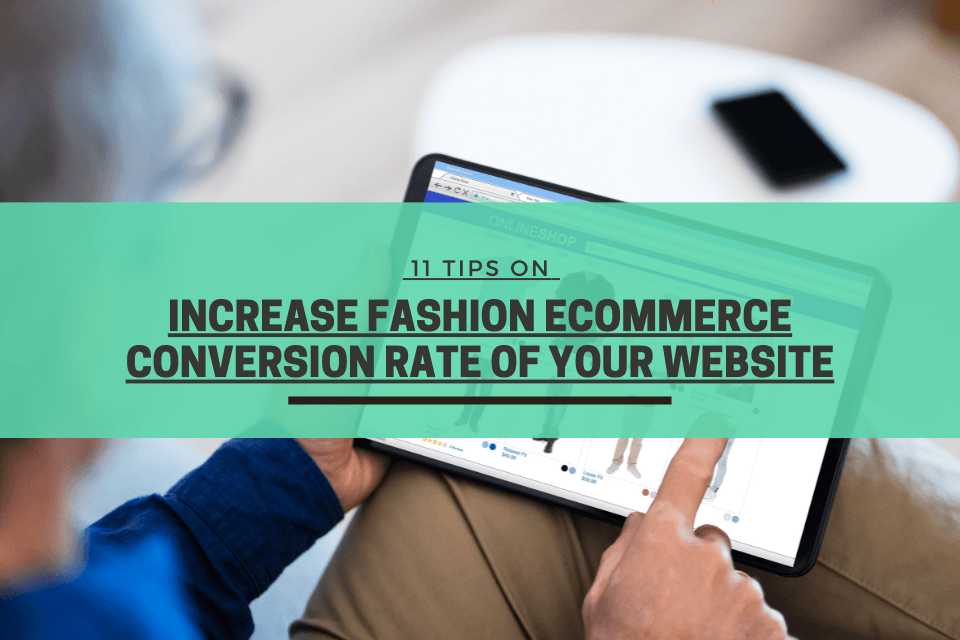This website uses cookies so that we can provide you with the best user experience possible. Cookie information is stored in your browser and performs functions such as recognising you when you return to our website and helping our team to understand which sections of the website you find most interesting and useful.
- Email: growth@growisto.com
- Phone: +1 628-280-9076
09 Sep

11 Tips on Increase Fashion eCommerce Conversion Rate of Your Website
As the fashion and eCommerce industry navigates the aftermath of the pandemic, there are new looks for the industry to try on. Affordable, yet sustainable fashion is on the rise, and the technological aspects are booming with grounds to flourish further in the wake of global changes.
Technology will dominate eCommerce for the fashion industry in 2021, by combining innovations with consumer preferences. The presence of a mere website is not enough, the customers expect modern online functionalities, immediate support at all times, and uninterrupted shopping experience across all touchpoints.
In this blog, we are going to look at key upcoming trends on your fashion eCommerce website that can monopolize the fashion eCommerce industry:
1. Variants:
In the fashion segment, products are available in multiple variants. Some of these variants are color, size, design, and material. Often, due to the limitations of the platform (especially Shopify and WooCommerce), brands are unable to show all the variants in one listing and are forced to create multiple listings. This leads to poor customer experience and reduced conversion. It is very important to choose a platform that can handle a large variety of variants easily. To avoid such problems, Shopify Plus or Magento are good alternatives.
2. Stock unavailability:
Another challenge faced around variants is the problem of going “out of stock” for some of the variants. Thus, a user who is looking for medium size T-shirt of a particular design gets disappointed when only a small size Tshirt is available in stock. In such cases, overall conversion reduces significantly. It is, therefore, necessary to stock out the entire range through clearance sales, for products that have very few variants left in stock.
3. Personalization:
AI-powered personalization tools are becoming increasingly necessary for fashion eCommerce. By leveraging data collected from customers such as their profile information, search behavior and purchase history, these tools create better and positive shopping experiences. Personalization across all touchpoints on a website can be achieved by employing AI.
For instance, visitors who have either browsed or bought men’s clothing frequently should get a personalized storefront experience highlighting those specific or similar products more. Another tactic could be utilizing customers’ purchase data to recommend deals or offers on products similar to the customer’s past purchases. These recommendations can then be sent out as tailored suggestions via emails or ads to the customers.
Implementing a personalized customer-centric approach helps in accelerating the shopping process, avoiding sales pushiness, and aligning towards customer’s actual goals and needs.
4. Product suggestions:
Similar product suggestions are another layer to add to your on-site strategy for the future. It helps you attract and further engage your users with items that can complement their selection. The visitors should have the ability to search similar products, matching accessories, and complementary pieces to their main choice.
Following is how you can recommend or set up product suggestions:
- Related Products- Products with similar names or descriptions, as well as products within the same category.
- Compatible Products- This showcases products that will compliment the users chosen products. These can be accessories or products that go with the product that is added to the cart.
- Customers also viewed- It follows the logic of “customers who viewed this product also viewed these products.”
5. Customized products:
Nowadays, users enjoy having some control over the clothes and accessories they purchase. Customized fashion is a growing trend throughout the fashion eCommerce industry. Customization enables shoppers to get pictures, designs, or taglines printed on their clothes and accessories. On an advanced level, they can even create individual designs for personalized products. Good modules, plugins or apps are not available in Shopify or Magento to create this feature. Growisto has used a ReactJS based front-end to create this feature easily.
6. Mobile-first approach:
Considering that 76% of the users shop via smartphones, it is vital for fashion brands to have a mobile-friendly eCommerce experience. There are various elements you need to consider while designing a mobile-first approach. For instance, mobile users are all about convenience and if your fashion site is not loading in an acceptable time frame, you need to extensively focus on it. Similarly, other features like- easier navigation/browsing through product listings, optimized product descriptions, and quick checkout process is necessary for increasing conversions through a mobile-first strategy.
7. SEO:
Due to multiple pages and filter options in fashion eCommerce, there could be millions of pages that can get created on a website. If all these pages are indexed in Google, the quality of the website is very poor from an SEO point-of-view, with several low-quality and duplicate pages. The right kind of pages should be submitted to Google for indexing and others should be marked as no-index. Further, URL parameters should also be handled properly. Is your website doing poorly on Google Search? Do check your URL parameters.
8. Return management:
Return management is very important as people want to try on various looks and explore new styles. The ability to return seamlessly gives them confidence in trying the same. Fashion brands need to clearly state their return and refund policies on their website, as well as clarify all the steps involved in the return process. A flexible and comfortable return process is always preferred by the consumers.
9. Images and videos:
Attractive visuals such as images and videos are already quite effective for eCommerce, especially for fashion eCommerce.
Fashion brands and portals should ensure that they upload high-quality images of the products. The main thumbnail in fashion should be larger in size as compared to a conventional eCommerce website. In-use images of the products (along with the model) should be showcased on the website. It is also very effective to add a 360-degree view of the product so that the users can inspect it from all angles.
Furthermore, shoppers are also attracted to videos because they feel more personal, authentic, and can provide relevant information. According to Forbes, 65% of customers are more likely to purchase a particular product after watching the product video.
The brands should experiment with the following kinds of video formats:
- Product Demos- Allow consumers to see a 360-degree view of the product, clearly explain and highlight major features, and answer common user questions.
- How-to videos- This is a popular video type that delves deeper into the product’s features and demonstrates how to use them.
- Lifestyle videos- Tell stories about your product and build a narrative around your brand.
10. Social media and recommendations:
Another way of increasing engagement on your fashion website, is through your social sharing abilities on products. Brands should ensure that the users can share the product with their friends and family through social media especially WhatsApp and other messenger apps to get recommendations from their friends.
Moreover, a large number of consumers are connecting with brands on social media these days, as this allows them to relate to brands on a personal level. Therefore integrating social media feeds into your website and easy navigation from social media to your website and vice versa is quite helpful.
11. Advanced features- AR/VR:
With more and more customers choosing to shop online, the ability to use fitting rooms and try-on clothes is decreasing significantly. This has led to an increase in the usage of Augmented Reality (AR) and Virtual Reality (VR) by fashion eCommerce brands.
For instance, the ability to try-on clothes from the comfort of your house is going to be a new trend in the fashion eCommerce field. AR and VR give shoppers access to in-store experiences, which in turn contributes to the growth of the brand. Through these, the customers can superimpose clothing on themselves and assess size as well as fit. These services assist and persuade customers in case they are unsure of how a particular product would fit them. This will significantly enhance the user experience, retain existing customers and attract new ones.
Additionally, high return rate is one of the biggest problems of fashion eCommerce brands. AR will help in the reduction of return rates, by assisting customers in making more accurate purchases.
All in all, as technology and customer preferences continue to evolve at a breakneck speed, the fashion eCommerce industry is trying to adjust to it.
Industries Served
United States
India











